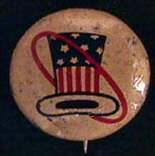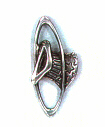|
 THE ORIGIN OF THE HAT-IN-THE RING
THE ORIGIN OF THE HAT-IN-THE RING
|
|
 � � � �  (l.)A War-vintage pin portraying the 94th.FS insignia. This was part of a collection available in boxes of cereal. (r.) A photograph of the original "Hat-in-the-Ring" pin given to Archie Jackson by Eddie Rickenbacker. |
By: Eddie Rickenbacker � � The expression of the "Hat-in-the-Ring" if memory does not fail me was created by President Theodore Roosevelt during one of his campaign speeches when running for the Presidency of the United States. � � When the 94th. Squadron, which was the first American Fighting Squadron to arrive on the Western Front, I was a member of it, and since all squadrons _ American and Allied alike- were known by a certain type of insignia as well as numbers, we naturally tried to find a design appropriate for our squadron. � � During many discussions, someone in our Squadron suggested using Uncle Sam's hat in colors, and automatically, someone else said, "Why not Uncle Sma's hat in the ring," was unanimously agreed uopn because it was so significant, realizing that this was America's first fighting squadron on the front and it was a logical tie-in for the insignia as it was designed. � � One of the pilots, Lt. Johnny Wentworth, happened to be an architect, and it fell to his lot to design, with the help of all others, this insigne which became world famous and which more or less became part of my life from that time on. The 94th. became known all over the world as the "Hat-in-the-Ring" Squadron or Rickenbacker's "Hat-in-the-Ring" Squadron, and after the war was over, it was used as my insignia or emblem on the Rickenbacker car for several years. � � Because of it being used on a commercial product, the Adjutant Genral instructed the 94th. Squadron of the Army Air Forces to discontinue its use, and the Indian Head was subtituted as the Squadron emblem of the 94th. During my trips throughout the United States for Genral Arnold, the purpose of which was to make a survey of our fighting Air Force combat units and to give them the benefit of my own experience and knowledge gained in World War 1, I had the opportunity of meeting the boys of this new 94th at Long Beach, California, where they were preparing to be activated to the European Theater with headquarters in England. � � At that time, I presented the Squadron with a l large emblem on a four foot square sheet of cardboard in colors which gave the boys national publicity, and upon my return to Mitchell Field, at the completion of my trip, I found a letter, copy of which is attached, from Genral Arnold designating the "Hat-in-the-Ring" as the emblem of the new 94th. Squadron. � � During World War 1, I took the design to a Paris jeweler and had a little insignia made up out of silver, which was worn by all the pilots of the 94th. above the wings on the left side of their tunic and was eventually recognized as the official insignia. � � On my trip to the Far East, I realized I would meet the 94th. Squadron again in North Africa and had several hundred of these silver insignia pins made up and was given the authority by General Arnold before leaving to present them to every member of the Sqaudron, both officers and enlisted personnel, and was authorized to tell them they could wear them as the officail insignia. � � This historical background has been carried on admirably from one war through to the next by the boys of World War II. � � Today, this Squadron is the only one equipped with the Lockhed P-80 Shooting Satrs, and on the side of this jet-propelled fighter plane is the "Hat-in-the-Ring" as is noticed by photgraphs which I recently received from the group commander. � � Nothing, in my opinion, symbolizes the spirit of the fight and challenge like this insignia,and so I have been given complete credit for its orgination that has become part of my life. |
By: Royal Frey � � Jack -- Here's the story on the Hat-in-the-ring that Rickenbacker told me, as best I remember it. First, you must realize that in the 1960s and early 1970s, he and I were very good friends. In fact, he was almost like a father in that he never once turned me down when I needed him to do something for the museum. Whenever he came to Dayton, I was his escort - met him when he arrived at the Dayton airport, stuck with him every minute, put him to bed, got him up in the morning, and took him back to the airport and got him back on his plane to NYC. He always had to ride TWA because Eastern didn't come into Dayton. He even stayed here at my home, with the undersyanding I wouldn't let the local newspapers know he was here. That poor fellow seldom had any peace and quiet if a news hawk was around. � � Anyway, here is the account. In the early 1920s when he was bringing out the Rickenbacker automobile, he wanted to use the old Hat- in-the- Ring as the auto's insigne. He said he contacted all of his old buddies (I assume he meant those pilots with whom he had flown in World War 1) and none of them objected, so he began to use it on his auto. He said that O.D. Hunter (who had stayed in the service) didn't like it and had the Hat-in-the-Ring cancelled out and the Indian Head of the 103rd. Aero Squadron (which evolved from the famous Escadrille Lafayette in Feb. 1918 in France) substituted to take its place, since the 103rd. was not reconstituted as an active duty outfit in the States following WWI. � � He said that in WWII when Hap Arnold asked him to visit the 94tth. to help inprove its morale, he said he would and that he'd like to pass out small Hat-in-the-Ring lapel buttons. He said that Arnold said he thought this was a good idea, and then Rickenbacker told him there was on problem - the 94th. insigne was the old 103rd. Indian Head, not the Hat-in-the-Ring. He said that Arnold turned around to his phone and called someone and told him to change the 94th. insigne back to the Hat-in-the-Ring, which was done immediately. � � Rickenbacker then told me that when he visted the 94th. in North Africa, he took along a supply of lapel Hat-in-the-Rings but he didn't have enough for every man in the squadron because the unit had alot more personnel assigned it than it had in WWI, and he hadn't brought along a sufficent number for every man. He added that he had later had more made and sent to the 94th. � � There you have it. This doesn't agree completely with his account in his autobiography that came out in 1967, and I don't have any explainantion for any conflicts, but I know that at the time he told the story to me, he was being completely truthful. He was not the type to twist facts, least not intentionally. I say this because I did catch him in an error regarding the death of Major Raoul Luftbury in May, 1918, but I knew the true facts because I had visted the place of his death and had dug out facts from those Frenchmen who had witnessed his final aerial combat that had never been revealed before, even to Rickenbacker. � � Talking about the WW1 Hat-in-the-Ring insigne from his planes, we had a couple at the USAF Museum and when Scott, Worden and Irwin were going to the moon on their Apollo mission,I got them to take along a large piece from one of his Hat-in-the-Rings. After they returned, they and Rickenbacker came to the museum for a public ceremony to return this priceless item to us for public display. This is the type of thing I used to dream up when I worked at the museum, which is why I always claimed that next to being a fighter pilot, I had the best job in the USAF. |

Capt. Eddie Rickenbacker and his Spad bi-plane. Note the insignia on the side of the aircraft.
|
� � Although I cannot shed any real light on the controversy regarding the actual regulations on the wearing of the pins I can however add that, in a conversation with Russell East, formerly a photographer with the 94th.FS, that he did indeed receive one of the pins, as he asked me if there was anywhere I knew to get another -- his being long since lost. This would add creedence to the statement that all of the personnel did receive one. Another note about Rickenbacker's article; in it he states that upon returning the insignia to the 94th., in April of 1942, it was on a square piece of cardboard, yet photographs show the insignia was indeed round. Of exactly what significance this error represents, I can not say. � � � These two articles contradict one another in many areas and in subsequent research I have only found more questions than answers concerning both matters. I will suffice it to say that, like the famous Blue Patch, and AAF Battle Jacket, all have gone down in history as some of the more interesting footnotes of the Second World War. � � For those of you not aware of the fact, Col. Royal Frey was the curator of the USAF Museum in his post-war life. He became close to many of the famous individuals of aviation history and was one of the strongest voices in proclaiming the greatness of both the 20th.Fighter Group (of which he was a member,) and Glenn Miller's music (of which he was perhaps the biggest fan who ever lived .) � |
A LETTER FROM EDDIE RICKENBACKER ON THE SUBJECT
THE OFFICAL DOCUMENTS CONCERNING THE INSIGNIA
RETURN TO FREY BIO � RETURN TO THE 1ST.FG
RETURN TO THE 20TH.FG
These articles reprinted fromKing's Cliffe Remembered
Unless otherwise noted, all content � copyright The Art of Syd Edwards 1998-1999. All rights reserved and reproduction is prohibited.
